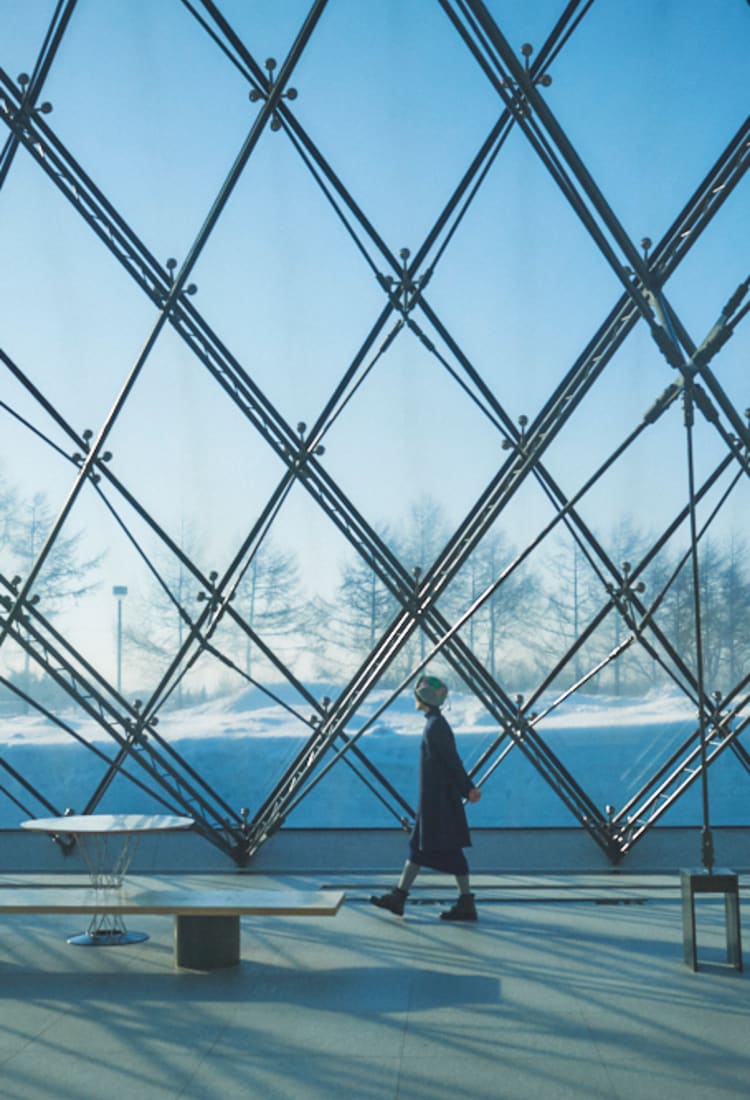
2020.12 Art, Nature and Cuisine in Sapporo—Gateway to Hokkaido
Visit Sapporo to experience a winter wonderland of spectacular art and delicious cuisine
Sapporo, a city of snow and art
Sapporo is the largest city in Hokkaido, with a population of around 1.9 million. The most famous draw in the city’s cultural calendar is the annual Sapporo Snow Festival, held in early February. Visitors will find the modern city easy to navigate as it was constructed with a grid street plan. Note that the 2021 Sapporo Snow Festival has been canceled to prevent the spread of coronavirus.
Moerenuma Park, an “earth sculpture” by Isamu Noguchi
Isamu Noguchi (1904–1988) was a Japanese-American sculptor, known as a key proponent of 20th century modernist style. Noguchi worked across the disciplines of sculpture, architecture and landscape design to bring his ideas to life. He designed renowned gardens in Paris and New York, but up until just before his passing he worked passionately to fuse art and nature at Sapporo’s Moerenuma Park.

Play Mountain in Moerenuma Park is an earth sculpture (left). The play area has a water feature inspired by a beach (right). Both photo credit: Courtesy of Moerenuma Park
Visitors to the park might be surprised to know that the idyllic landscape seen today was once a waste treatment plant. In the 1970’s, the area served as landfill for around 2.7 million tons of garbage. When Noguchi visited the site, he decided to join the project to transform the park, saying he would remake the land that had been damaged by humans into art.
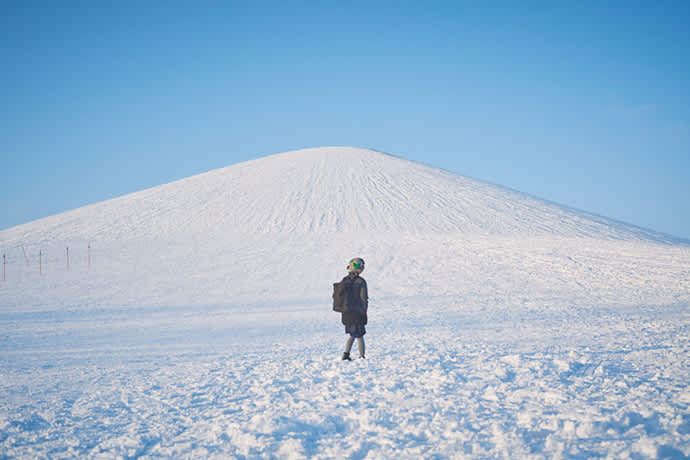
Mt. Moere is formed from non-burnable waste and soil leftover from construction.
Noguchi had wanted to create a sculpture from earth long before he saw the park. After becoming involved in the project, he drew up a plan based on the concept that the entire park would be a sculpture and that it would complement the surrounding environment. Examples of this natural harmony are the park's two mountains, Mt. Moere at 52 meters (170 ft.) and the 30-meter high (98 ft.) Play Mountain. Noguchi also designed the Glass Pyramid, called Hidamari, as a tribute to the work of architect I.M. Pei, who designed the glass pyramid at Paris’ Louvre museum.

From the top of Mt. Moere, you can see features such as Play Mountain and the Glass Pyramid called Tetra Mound.
According to Moerenuma Park curator Kazumi Miyai, looking down from the mountaintop really brings Noguchi’s vision of the entire park as a sculpted artwork into focus. The expansive view of triangular and circular shapes communicates his detailed blueprint for the park.

The Glass Pyramid “Hidamari”, composed of complex geometric shapes was also designed by Noguchi.
“The park is beautiful in winter when it is blanketed in snow,” says Kazumi. Visitors can immerse themselves in Noguchi’s world and have fun at the same time by sledding or renting snowshoes and clambering up Mt. Moeru.
Moerenuma Park is approximately 50 minutes east of central Sapporo and accessible by subway and bus.

In winter (January–March), you can rent a sled or snow shoes in the park for a fee.
A one-of-a-kind temple, designed by Tadao Ando
The Hill of the Buddha at Makomanai Takino Cemetery was designed by the globally renowned architect, Tadao Ando (b.1941). The structure is a temple, constructed to resemble a hill housing a Great Buddha, Atama Daibutsu. Ando, who was inspired by architects Le Corbusier and Frank Lloyd Wright, is adept at balancing elements of concrete and nature, light and shadow. The Hill of the Buddha is a grand embodiment of that ability, creating harmony between the Great Buddha and the surrounding landscape. Ando has won many awards for his visionary work, including the Pritzker Architecture Prize, considered the “Nobel Prize of architecture”.

A concrete corridor encircles the Great Buddha. The appearance of the statue varies throughout the day, depending on the direction of light.
The Hill of the Buddha occupies part of the vast cemetery. Tadao Ando conceived of a distinctive landscape where only the head of the 13.5-meter-tall (44.2 feet) Great Buddha would be visible on top of the hill. It’s a bold addition to the cemetery, as the design encloses the Buddha, revealing just the head, to inspire the imagination.

The lavender that covers the hill blooms around mid-July. Photo credit: Makomanai Takino Cemetery
With the seasonally changing landscape, visitors are offered different perceptions of the giant art piece. Fresh greenery covers the hill in spring; lavender creates a purple carpet in the summer, and snowfall blankets the hill in winter.
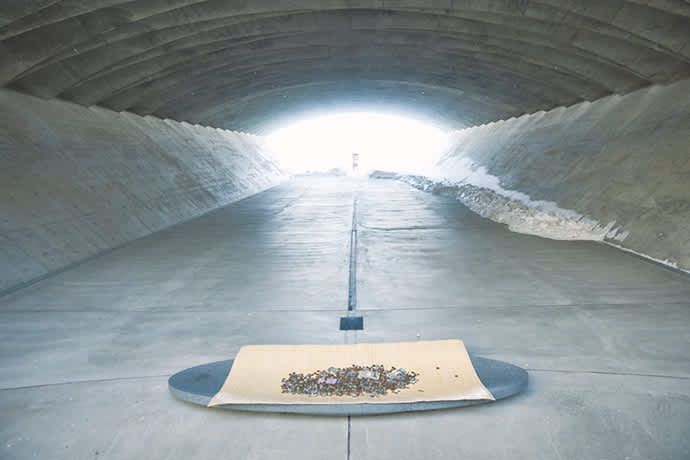
A tunnel inside the hill leads visitors between the secular and sacred worlds.
A concrete tunnel inside the hill leads visitors to the temple surrounding the Great Buddha. Pass through the dim tunnel and the Great Buddha is revealed, encircled by a halo of sky.

Visitors pass through a tunnel to reach the Great Buddha.
There is no roof on the space housing the Great Buddha. In winter, snow covers the head and body, and the sight of the Great Buddha enduring the cold is a beautiful and inspiring sight.
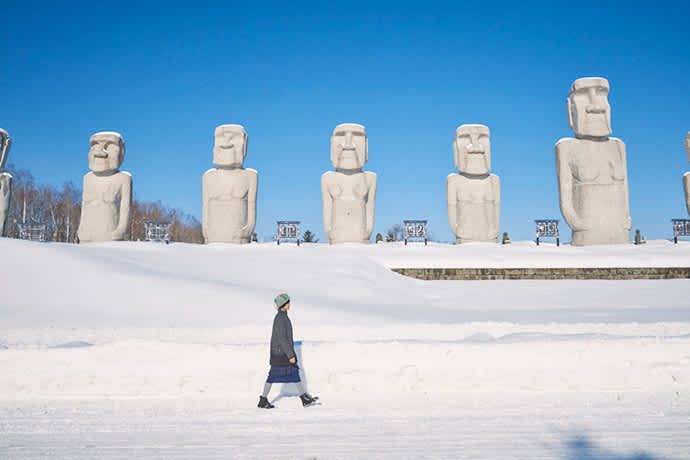
Moai statues line the main entrance to Makomanai Takino Cemetery.
Inside the Makomanai Takino Cemetery, Moai statues and sculptures suggestive of Stonehenge have become symbols of the cemetery, which is open to all people regardless of beliefs. Incidentally, the Moai of Easter Island are said to embody the spirits of ancestors. The “mo” means future, and the “ai” means living, as they pass their legacy to future generations. At Makomanai Takino Cemetery, they are symbols dedicated to ancestors, regardless of religious affiliation.
Near the Stonehenge area, the cemetery is lined with graves, and memorial services are held for those whose relatives cannot visit. These graves ensure that those departed are not forgotten and give hope to future generations. Though the cemetery is open to all visitors, you are asked to remember to be respectful and considerate when strolling the grounds. Makomanai Takino Cemetery is about 50 minutes south of central Sapporo by subway.
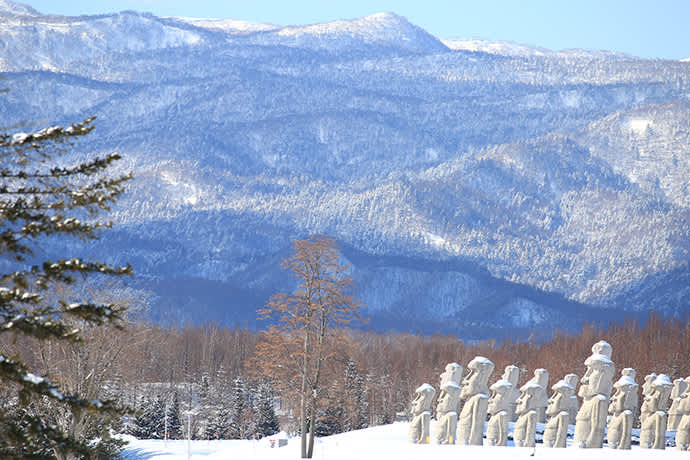
Snow covers the Moai statues and surrounding mountains in winter. Photo credit: Makomanai Takino Cemetery
Natural ice art at Shikotsu-Toya National Park
Art comes in many guises, and nature produces some of the most dramatic artworks. Visiting a national park in winter is a great opportunity to see natural art. Lake Shikotsu near New Chitose Airport, is a caldera lake, known for its vivid color and a popular ice festival. The lake’s clear water is known as “Lake Shikotsu blue,” and Japan’s Ministry of the Environment has consistently ranked the lake as having the country’s highest quality water (11 consecutive years from 2007–2017).

Lake Shikotsu is a caldera lake, formed approximately 32,000 years ago by volcanic activity. Photo credit: Chitose Tourist Association
Chitose and Lake Shikotsu Ice Festival is held every winter by the lakeshore. It displays around 30 ice sculptures of varying sizes between late January and February every year, and is scheduled for January 29 to February 23 in 2021. *The festival may be significantly affected by COVID-19.
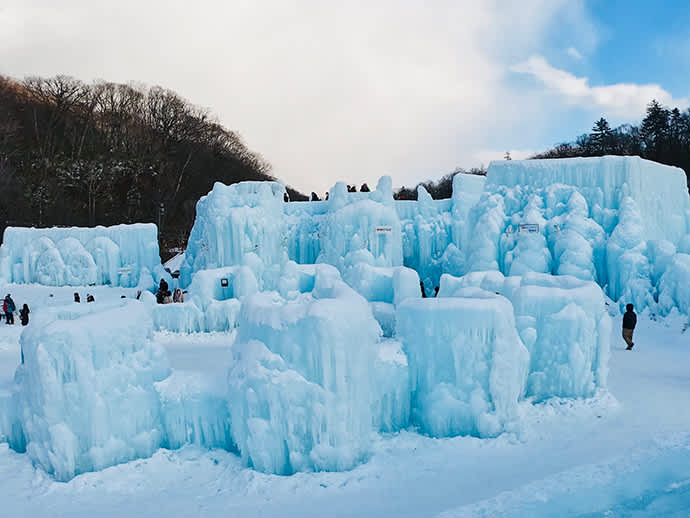
Ice sculptures sparkle blue in the sunlight. Photo credit: Chitose Tourist Association
Ice sculptors spray their works with lake water, which freezes and adds a natural element to the sculptures. According to festival operator Kazuhiko Maeda from the Chitose Tourist Association, about 15 staff members create the artworks over a period of around three months. During the final month, the staff carry out the finishing touches at night when temperatures can drop to -20 degrees Celsius (-4 degrees Fahrenheit) or below.
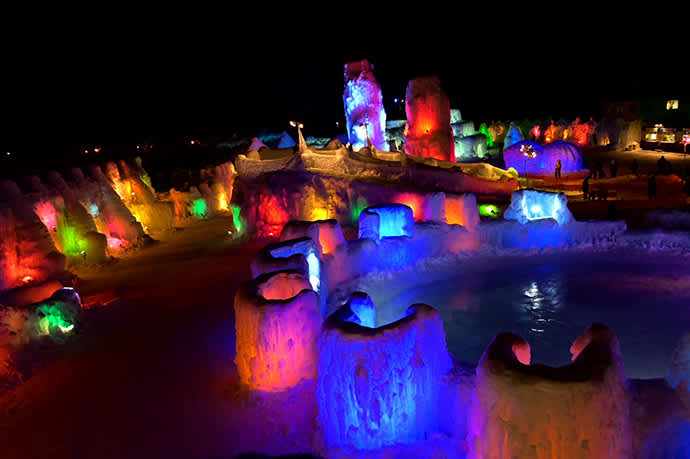
Multicolored lights illuminate the sculptures at night. Photo credit: Chitose Tourist Association
During the day, the ice sculptures sparkle in signature “Lake Shikotsu blue” as they catch the sunlight. At night, magical lights illuminate them, creating a winter wonderland. Visitors to the event can see how translucent lake water and a frigid environment are utilized to create art inspired by nature and guided by human hands.
Sapporo is the perfect destination for foodies to experience the art of cuisine
Food tourism has become a travel trend, as foodies seek out location-specific foods and gourmet experiences. In Sapporo, discover dishes that are specific to Hokkaido, from elegant sushi to hearty curries.
Artful sushi to stimulate all five senses
Sushi Himeshara boasts a sushi chef who turns fresh seafood into sushi art. The top-class restaurant in the Maruyama Park area in west Sapporo has previously earned two Michelin stars. The chef and owner, Akira Tanaka, selects the freshest local seafood from Hokkaido and across Japan.
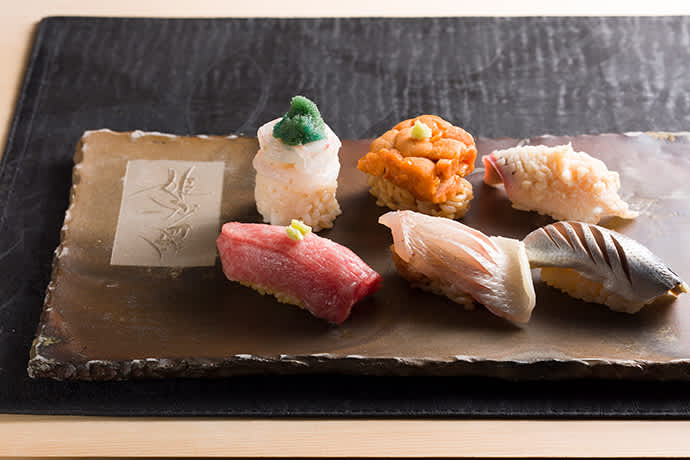
Each ingredient is finely crafted to create nigiri (hand-shaped sushi) with visual appeal and flavor. Photo credit: Himeshara
The “Sushi and Himeshara Course,” prepared with seasonal ingredients, is the only option on the menu. The creative course starts with sushi, moves to small individual dishes, and finishes with nigiri. It is served with Japanese sake that complements each dish.

An assortment of small dishes, created by up-and-coming artists from Hokkaido (left). The interior décor is pared down so that guests can concentrate on the meal (right). Both photo credit: Himeshara
The sushi chef and owner, Akira Tanaka believes that using high-quality, fresh fish is only to be expected in Hokkaido, which is famous for its fresh catch. He strives to serve sushi that is a feast for the senses, through the careful selection of superior fish and rice, and artistic presentation. He follows the Tokyo-style of sushi, exercising creativity by preparing fresh fish according to its qualities on the day, such as marinating, simmering, or adding vinegar and salt. The meal is meticulously constructed to enhance the merits of each fish.

Akira Tanaka has devoted himself to mastering sushi and Japanese cuisine for 37 years. Photo credit: Himeshara
One example of the chef’s meticulous presentation is the “whole shrimp topping.” Akira Tanaka arranges a raw botan shrimp in a spiral before stuffing it with shrimp innards and topping it off with shrimp roe. Crafted this way, the rich flavor of the shrimp is brought to the fore. The dishes are paired with sake to enhance the flavors. Dining at Sushi Himeshara is an opportunity to experience the essence of Japanese food culture.
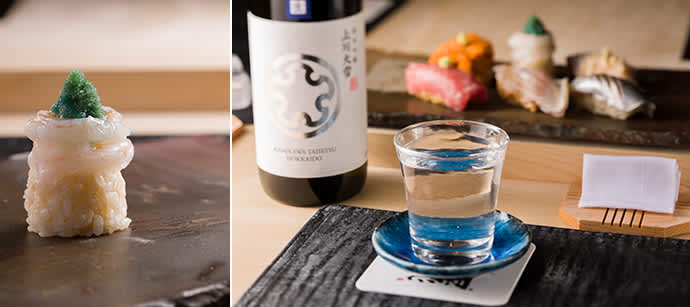
“Whole shrimp topping” has a design registration recognizing its creative beauty. (left) Sushi and Japanese sake is the ultimate pairing. (right) Photo credit: Himeshara
Soup curry: a dish that brings together the flavors of Hokkaido
“Soup curry” is a popular dish from Sapporo that features large chunks of vegetables and meat in a spicy curried soup. Rice is served separately. The dish is said to have originated from a coffee shop in Sapporo in the 1970s that offered a special curry combining Indian spices with a healthy, herbal soup. Soup curry was a popular local draw before its evolution over time rooted it firmly in Sapporo’s food culture. Today, there are over 200 specialty soup curry restaurants in Sapporo alone.
Since its establishment in 2001, Soup Curry Cocoro has consistently dominated the soup curry scene. Its signature dish was listed in the 2017 edition of the Michelin Hokkaido guide. The restaurant’s main location is located a 20-minute walk (approximately 1.5 kilometers or 0.9 miles) north of Sapporo Station.

The specialty, “soup curry with chicken on the bone” is served with a large chicken leg. Photo credit: Soup Curry Cocoro
Head chef Katsuya Hiraki has a background in art. He creates his signature recipes based on French techniques with Sri Lankan curry spices, Japanese soup stock, and the heat of Szechuan peppercorns. He simmers chicken, pork, and beef bones, vegetables, potherbs, fragrant herbs, and other ingredients for over 10 hours to produce a spicy soup with a distinctive mild sweetness and rich flavor.

“Seafood soup curry” served with a generous amount of seafood, such as shrimps, scallops, squids and clams. Photo credit: Soup Curry Cocoro
Katsuya Hiraki sources ingredients from Hokkaido including fresh seafood, and “Nanatsuboshi” rice from Yubari, east of Sapporo. The rice has firm grains and a delicate sweetness that matches well with the soup. The potatoes in the soup curry are a special variety called “Hokkai No. 50”, grown for the restaurant by contract farmers. The chef parboils them whole, then lightly deep fries them to create a floury, springy texture.

Rice farmers from Goto Farm pose with Chef Hiraki (center). Goto Farm rice was deemed high enough quality to be served to the emperor. Photo credit: Soup Curry Cocoro
The chicken in the signature dish, “soup curry with chicken on the bone,” is slowly simmered and served so tender that it falls off the bone. Other popular dishes are, “chicken and vegetable soup curry” and the “Hiroshima oyster soup curry,” a winter-only dish.
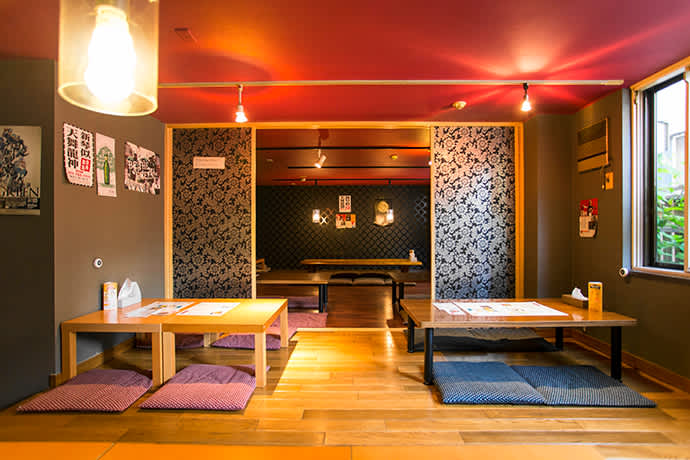
Soup Curry Cocoro has both table and floor seating, and menus are available in English and Chinese. Photo credit: Soup Curry Cocoro
Information
Moerenuma Park |
Makomanai Takino Cemetery |
Sushi Himeshara |
Soup Curry Cocoro, main location in Sapporo |
Related Links
Sapporo Tourist Association |
Shikotsu-Toya National Park |
|
WEB:https://www.japan.travel/national-parks/parks/shikotsu-toya/ |




















































